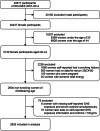Joint effect of 25-hydroxyvitamin D and secondhand smoke exposure on hypertension in non-smoking women of childbearing age: NHANES 2007-2014
- PMID: 34781965
- PMCID: PMC8591921
- DOI: 10.1186/s12940-021-00803-1
Joint effect of 25-hydroxyvitamin D and secondhand smoke exposure on hypertension in non-smoking women of childbearing age: NHANES 2007-2014
Abstract
Background: Vitamin D deficiency (VDD) may increase the risk of hypertension in women of childbearing age, who may be exposed to secondhand smoke (SHS) simultaneously. Till now, few studies have investigated the joint effects of VDD and SHS on hypertension in this population. We evaluated whether exposure to SHS modified the association between VDD and hypertension.
Methods: Data from National Health and Nutrition Examination Surveys (NHANES) 2007-2014 were analyzed. Our research subjects were 2826 nonsmoking and nonpregnant women of childbearing age (20-44 years old). Hypertension was defined based either on systolic blood pressure (SBP) ≥ 130 mmHg and/or diastolic blood pressure (DBP) ≥ 80 mmHg or on now taking prescribed medicine for hypertension. The directed acyclic graphs (DAG) and the back-door criterion were used to select a minimal sufficient adjustment set of variables (MSAs) that would identify the unconfounded effect of 25(OH)D and hypertension. The interactive effect of VDD and SHS on hypertension was evaluated by using logistic regression models, followed by strata-specific analyses.
Results: The prevalence of VDD in the hypertension group was significantly higher than that in the non-hypertension group (48.2% vs 41.0%, P = 0.008), as well as the exposure rate of SHS (39.1% vs 33.8%, P = 0.017). VDD was independently associated with nearly 50% increased risk of hypertension [adjusted odds ratio (aOR) = 1.43, 95% confidence interval (CI): 1.01, 2.04], while no significant association was observed between SHS and hypertension. However, SHS showed a significant synergistic effect on VDD with a higher aOR of 1.79 (95% CI: 1.14, 2.80) (Pinteraction = 0.011). This synergistic effect was more obvious when stratified by BMI (in overweight women, aOR, 95% CI =4.74, 1.65-13.60 for interaction vs 2.33, 1.01-5.38 for VDD only) and race (in Non-Hispanic Black women, aOR, 95% CI =5.11, 1.58-16.54 for interaction vs 2.69, 1.10-6.62 for VDD only).
Conclusion: There exist synergistic effects of SHS and VDD on the prevalence of hypertension in American women of childbearing age, with more significant effects in women who were overweight or Non-Hispanic Black. Further studies are warranted to verify this finding in other populations, and the molecular mechanisms underlying the joint effect of SHS and VDD need to be elucidated.
Keywords: 25-hydroxyvitamin D; Hypertension; Interaction; Secondhand smoke; Women of childbearing age.
© 2021. The Author(s).
Conflict of interest statement
The authors declared that they have no competing interests.
Figures




Similar articles
-
A synergistic effect of secondhand smoke with vitamin D deficiency on cognitive impairment in older adults: a cross sectional study.Front Nutr. 2025 Feb 11;12:1533193. doi: 10.3389/fnut.2025.1533193. eCollection 2025. Front Nutr. 2025. PMID: 40008315 Free PMC article.
-
Associations of exposure to secondhand smoke with hypertension risk and blood pressure values in adults.Environ Health Prev Med. 2021 Sep 6;26(1):86. doi: 10.1186/s12199-021-01009-0. Environ Health Prev Med. 2021. PMID: 34488622 Free PMC article.
-
Association between secondhand smoke exposure and hypertension in never smokers: a cross-sectional survey using data from Korean National Health and Nutritional Examination Survey V, 2010-2012.BMJ Open. 2018 May 14;8(5):e021217. doi: 10.1136/bmjopen-2017-021217. BMJ Open. 2018. PMID: 29764884 Free PMC article.
-
Secondhand Smoke Exposure Among Nonsmoking Youth: United States, 2013-2016.NCHS Data Brief. 2019 Aug;(348):1-8. NCHS Data Brief. 2019. PMID: 31442196 Review.
-
Reducing Secondhand Smoke Exposure Among Nonsmoking Pregnant Women: A Systematic Review.Nicotine Tob Res. 2020 Dec 12;22(12):2127-2133. doi: 10.1093/ntr/ntaa089. Nicotine Tob Res. 2020. PMID: 32428216
Cited by
-
Association between Sensitivity to Thyroid Hormone Indices and Bone Mineral Density in US Males.Int J Endocrinol. 2022 Oct 26;2022:2205616. doi: 10.1155/2022/2205616. eCollection 2022. Int J Endocrinol. 2022. PMID: 36340930 Free PMC article.
-
Inverse association between serum iron levels and Hashimoto's thyroiditis in United States females of reproductive age: analysis of the NHANES 2007-2012.Front Nutr. 2024 Oct 1;11:1410538. doi: 10.3389/fnut.2024.1410538. eCollection 2024. Front Nutr. 2024. PMID: 39416653 Free PMC article.
-
Non-high-density lipoprotein cholesterol to high-density lipoprotein cholesterol ratio (NHHR) and hypertension in American adults: a NHANES cross-sectional study.Front Physiol. 2024 Aug 13;15:1398793. doi: 10.3389/fphys.2024.1398793. eCollection 2024. Front Physiol. 2024. PMID: 39193442 Free PMC article.
-
The roles of serum vitamin D and tobacco smoke exposure in insomnia: a cross-sectional study of adults in the United States.Front Nutr. 2023 Dec 18;10:1285494. doi: 10.3389/fnut.2023.1285494. eCollection 2023. Front Nutr. 2023. PMID: 38170097 Free PMC article.
-
Association between secondhand smoke exposure and serum sex hormone concentrations among US female adults: a cross-sectional analysis using data from the National Health and Nutrition Examination Survey, 2013-2016.BMJ Open. 2024 May 15;14(5):e073527. doi: 10.1136/bmjopen-2023-073527. BMJ Open. 2024. PMID: 38749695 Free PMC article.
References
-
- Song JJ, Ma Z, Wang J, Chen LX, Zhong JC. Gender differences in hypertension. J Cardiovasc Transl Res. 2020;13(1):47–54. - PubMed
-
- Forouzanfar MH, Liu P, Roth GA, Ng M, Biryukov S, Marczak L, et al. Global burden of hypertension and systolic blood pressure of at least 110 to 115 mm hg, 1990-2015. JAMA. 2017;317(2):165–182. - PubMed
-
- Kearney PM, Whelton M, Reynolds K, Muntner P, Whelton PK, He J. Global burden of hypertension: analysis of worldwide data. Lancet. 2005;365(9455):217–223. - PubMed
-
- Liu X, Olsen J, Agerbo E, Yuan W, Wu CS, Li J. Maternal preeclampsia and childhood asthma in the offspring. Pediatr Allergy Immunol. 2015;26(2):181–185. - PubMed
Publication types
MeSH terms
Substances
Grants and funding
LinkOut - more resources
Full Text Sources
Medical

